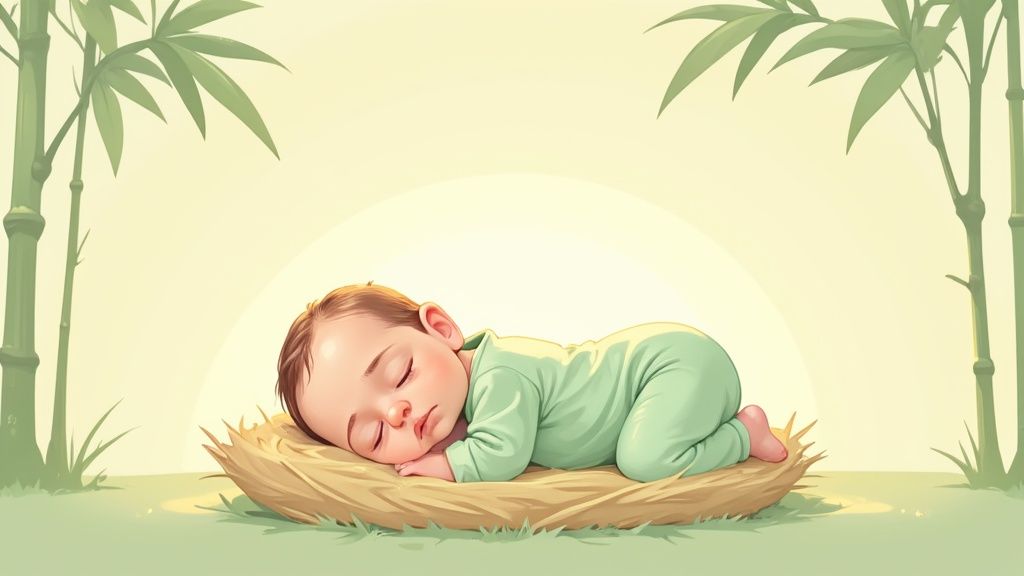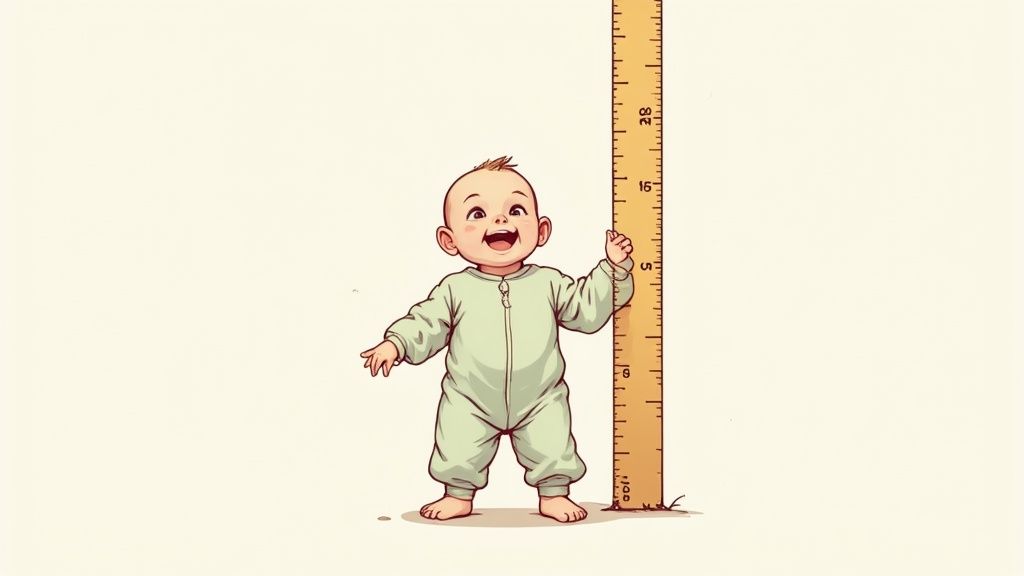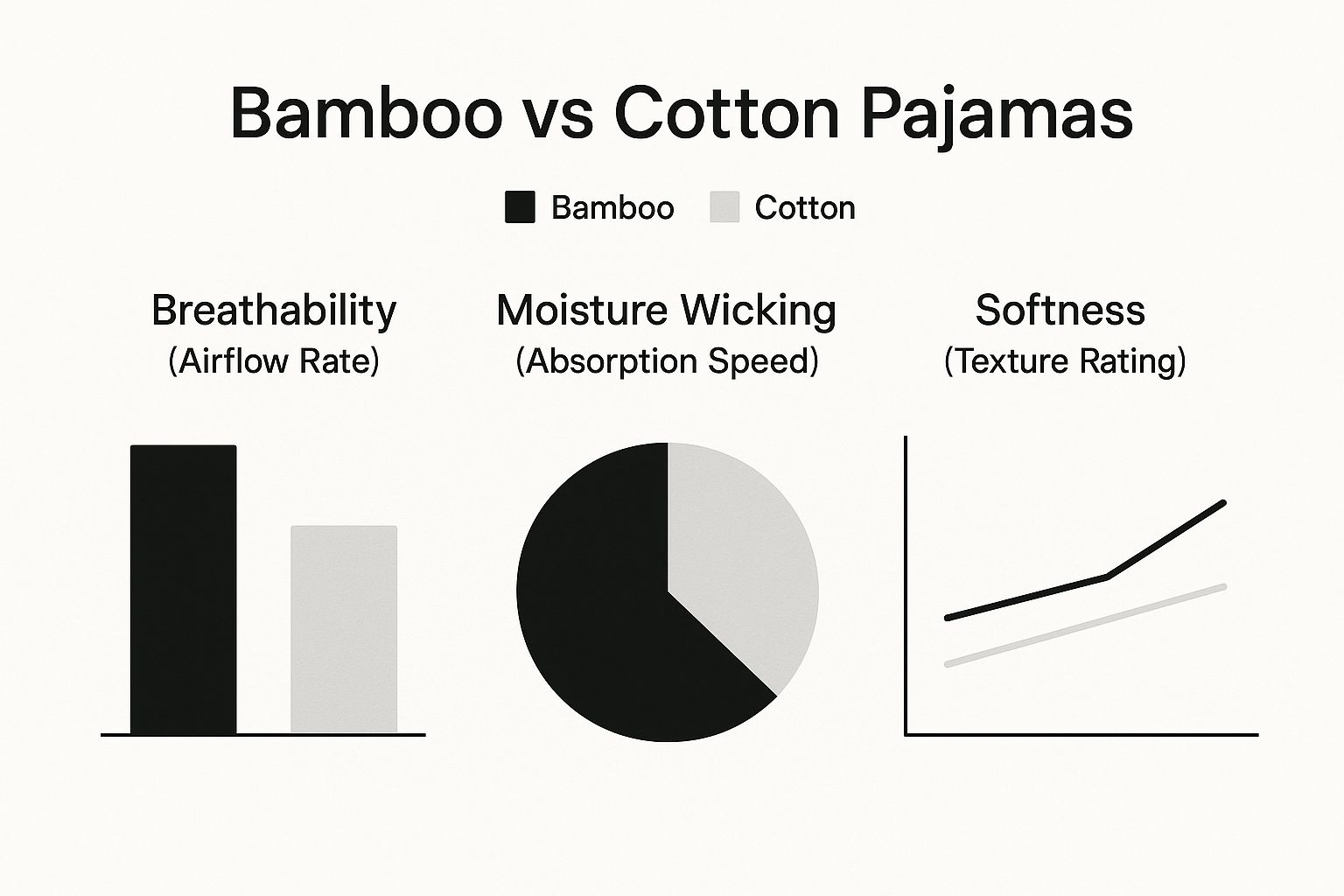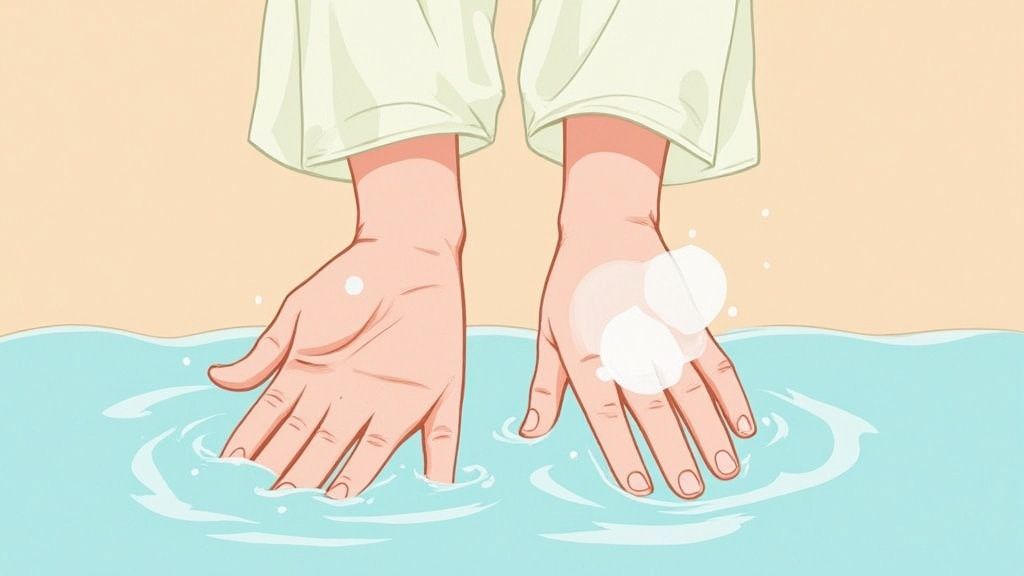
Why Choose Bamboo Pajamas Baby Sleepwear?
Share
Have you noticed bamboo baby pajamas everywhere lately? It’s not just you. More and more parents are discovering what makes this fabric so special for their little ones' sleepwear. It’s a move toward something better, blending incredible comfort with smart, practical benefits.
So, what's all the buzz about? It really comes down to a few key things that give parents peace of mind and help babies sleep soundly.

The first thing you’ll notice is the feel. Bamboo viscose is ridiculously soft. Think buttery, silky, and unbelievably gentle—exactly what you want next to a baby's delicate skin. This amazing texture helps reduce irritation, making it perfect for little ones with sensitive skin or eczema.
But the magic of bamboo goes way beyond just being soft.
It's All About Comfort and Performance
Bamboo fabric is a true performance material, and its best trick is temperature regulation. This is a huge deal for babies, who can't regulate their own body temperature very well yet.
On warm nights, the fabric is breathable and wicks moisture away, keeping your baby cool and dry. When it gets chilly, bamboo acts as a cozy insulator, providing warmth without the risk of overheating. It’s a smart fabric that adapts, which is why so many parents rely on it year-round. You can dive deeper into this topic in our guide on what makes bamboo pajamas perfect for all seasons.
This shift isn't just a small trend. The baby apparel market, valued at a massive USD 227 billion in 2024, is seeing a huge demand for sustainable and high-quality fabrics like bamboo. It's clear that modern parents are looking for products that are good for their kids and the planet.
To give you a quick snapshot, here’s a breakdown of what makes bamboo pajamas such a popular choice.
Why Parents Choose Bamboo Pajamas
This table offers a quick look at the standout features that make bamboo a top choice for baby sleepwear.
| Key Feature | What It Means for Your Baby |
|---|---|
| Buttery-Soft Texture | Incredibly gentle on delicate and sensitive skin, minimizing irritation. |
| Temperature Regulating | Keeps your baby cool when it's hot and warm when it's cold. |
| Moisture-Wicking | Pulls sweat and moisture away from the skin, keeping them dry and comfy. |
| Hypoallergenic | Naturally resistant to allergens, making it ideal for babies with eczema or allergies. |
| Stretchy Fit | Offers a snug, flexible fit that moves with your baby and lasts through growth spurts. |
Ultimately, choosing bamboo pajamas is about investing in your baby’s comfort and getting a better night's sleep for the whole family. It's that simple.
How Bamboo Fabric Soothes a Baby's Sensitive Skin
A baby’s skin is unbelievably delicate—it's much thinner and more porous than our own. I like to think of it as a brand-new, super-soft sponge that just soaks up everything it touches. This is exactly why picking the right fabric for their PJs is a huge deal, especially for little ones with sensitive skin, eczema, or rashes.
Bamboo fabric isn't just soft; it creates a gentle, protective little bubble for their skin. The magic is in the bamboo fibers themselves. They're naturally round and smooth, so they don't have the microscopic sharp bits you might find in wool or even some lower-grade cottons. Less friction means less chance of irritation and redness.

It’s this gentle touch that has so many parents switching to higher-quality sleepwear. The global market for baby sleepwear hit around USD 4.5 billion in 2024, and it's growing fast as more of us look for materials that genuinely support our babies' health. It’s a clear shift toward fabrics that do more than just feel nice.
A Hypoallergenic Haven
If you have a baby with allergies or eczema, you know that bedtime can sometimes feel like a battle. The wrong PJs can trap allergens like dust mites and pollen, leading to flare-ups and a rough night for everyone. This is where bamboo pajamas for a baby really shine, offering a natural defense.
Bamboo is naturally hypoallergenic. It just doesn't attract or hold onto allergens. The plant itself is resistant to pests and fungi, which means it can be grown without a bunch of nasty pesticides. That natural purity carries right through to the finished fabric, giving your baby a cleaner, safer surface to sleep on.
As a parent of a child with sensitive skin, finding a fabric that actively calms and protects can feel like a massive victory. Bamboo offers that kind of peace of mind.
If you're curious about how different materials compare, we put together a guide on the best fabric for sensitive skin that really gets into the details.
Keeping Them Dry and at the Perfect Temperature
Moisture is one of the biggest triggers for skin irritation. A sweaty baby is almost always an uncomfortable, rash-prone baby. Bamboo is a pro at moisture management. It pulls dampness away from the skin so it can evaporate in a flash.
It’s kind of like those high-tech workout shirts we wear, but designed for tiny dreamers. This wicking power keeps your baby’s skin dry and helps prevent the buildup of bacteria that can cause diaper rash or heat rash, especially when they're bundled up.
This leads right into bamboo's most famous feature: thermal regulation. It’s like a personal thermostat built right into the fabric.
- On warm nights: The fabric is incredibly breathable. Microscopic gaps let air flow freely, helping heat escape to keep your baby cool.
- On cool nights: Those same fibers trap warm air close to the body, creating a cozy layer of insulation that keeps them warm without ever getting too hot.
This amazing adaptability means your baby stays at a comfortable, consistent temperature all night long. That leads to safer, deeper sleep—which is a win for everyone. It makes bamboo pajamas the perfect choice, no matter the season.
Are Bamboo Pajamas Really an Eco-Friendly Choice?
When you’re picking out pajamas for your little one, softness is a top priority. But if you're reaching for bamboo, you're probably also thinking about making a better choice for the planet. So, is bamboo fabric really as green as it’s cracked up to be? The answer isn't a simple yes or no—it’s a bit more complicated, and it all starts with the plant itself.
In its natural state, bamboo is a sustainability powerhouse. This stuff grows fast. We're talking about a plant that can shoot up several feet in a single day, which makes it an incredibly renewable resource. Plus, it’s not nearly as thirsty as conventional cotton. While cotton fields demand massive amounts of irrigation, bamboo is often perfectly happy with just natural rainfall.
Best of all, bamboo doesn’t need a lot of chemical intervention. It has natural antimicrobial properties that ward off pests, meaning farmers don’t have to douse it in pesticides or fertilizers. That’s a huge win for keeping our soil and waterways clean.
From Plant to Pajamas: The Messy Middle Part
Here’s where the eco-friendly story gets a little more complex. Turning that tough, woody plant into the silky-soft fabric we love is a multi-step process. The most common method creates what's known as bamboo viscose or rayon. This involves using chemicals to break down the bamboo pulp into a gooey substance that can then be spun into fibers.
If not handled correctly, this traditional viscose process can be pretty harsh on the environment. This is why it’s so crucial to pay attention to the brands you buy from and how transparent they are about their manufacturing.
The real secret to sustainable bamboo pajamas isn't just the plant—it's the process. When you choose brands that are serious about responsible production, you can rest easy knowing your baby's comfort isn't costing the planet.
Thankfully, there are much greener ways to do things. A method called the lyocell process, for instance, is a game-changer. It uses a non-toxic solvent in a "closed-loop" system where over 99% of the water and solvent are captured and reused again and again. This drastically cuts down on waste and pollution.
When you look at how bamboo and cotton stack up for your baby's comfort, the differences become even clearer.

As you can see, bamboo just performs better when it comes to breathability and keeping your baby dry and comfortable. That’s why ensuring it's sourced and made responsibly matters so much.
Let's take a quick look at how the raw materials—bamboo and conventional cotton—compare from an environmental standpoint.
Bamboo vs Conventional Cotton for the Planet
| Environmental Factor | Bamboo | Conventional Cotton |
|---|---|---|
| Water Consumption | Requires minimal water, often only rainwater. | Extremely thirsty; one of the most water-intensive crops. |
| Pesticide Use | Naturally pest-resistant, requires no pesticides. | Heavily reliant on pesticides (16% of world's total). |
| Growth Rate | Extremely fast-growing and regenerates from its own roots. | Slower-growing, requires annual replanting which degrades soil. |
| Land Use | High yield per square foot. | Lower yield, requires more land to produce the same amount of fiber. |
The table really drives home why bamboo, as a raw material, has such a head start in the sustainability race.
Making a Genuinely Green Choice
So, how do you make sure the bamboo pajamas your baby is wearing are truly as eco-friendly as possible? It comes down to looking for a few key signs of responsible production.
- Look for Certifications: Keep an eye out for the OEKO-TEX® Standard 100 label. This is a big one. It guarantees that every single part of the garment—from the thread to the snaps—has been tested and is free from harmful substances.
- Demand Transparency: Go with brands that aren't afraid to talk about how their products are made. Companies that are truly committed to sustainability are usually proud to share the details of their supply chain.
- Check the Fabric Type: If you have the option, choose bamboo lyocell over standard viscose. Its closed-loop manufacturing process gives it a much better environmental footprint.
By being a savvy shopper, you can feel great knowing you’ve picked pajamas that are not only gentle on your baby's skin but also kinder to our planet. If you want to dig even deeper, check out this great resource on the benefits of choosing bamboo over cotton for toddler clothing.
Choosing the Right Fit for Comfort and Safety

So, you’ve discovered how amazing bamboo fabric feels, and you’re ready to wrap your little one in all that softness. The next big step is getting the fit just right. For babies, this isn't just about looking adorable—it's a massive part of keeping them safe while they sleep.
This is where things like safety certifications and sleepwear rules come into play. It might sound a bit technical, but it’s super important.
Ever noticed the OEKO-TEX® Standard 100 label on really good baby clothes? Think of it as a gold star for safety. It’s a guarantee that every single part of the pajamas—from the fabric and thread right down to the zipper—has been tested and cleared of more than 100 nasty chemicals.
When you choose bamboo pajamas baby sleepwear that's OEKO-TEX certified, you get that priceless peace of mind knowing what’s right up against your baby’s delicate skin is pure and harmless.
Why a Snug Fit Is the Safest Fit
Have you ever pulled a pair of baby pajamas off the rack and thought, "Wow, these look tiny!" There’s a really good reason for that snug design, and it’s not just for style. It’s actually a federal safety requirement.
The U.S. Consumer Product Safety Commission (CPSC) has regulations that say children's sleepwear has to be one of two things: either flame-resistant or tight-fitting.
Loose, baggy pajamas have a greater chance of catching fire if they happen to brush against something like a candle or a space heater. To get around this, some companies treat their fabrics with flame-retardant chemicals. The other, more natural option? A snug fit.
By choosing snug-fitting pajamas made from naturally sourced materials like bamboo, you can avoid exposing your baby to unnecessary chemicals while adhering to the highest safety standards.
That's why you’ll often see a tag that says something like, "wear snug-fitting, not flame resistant." It’s the brand's way of telling you they’re putting your baby's safety first without resorting to harsh chemicals.
Getting the Sizing Just Right
Okay, let's nail down that perfect snug fit—one that’s safe without feeling like a straightjacket. One of the absolute best things about bamboo viscose is its incredible four-way stretch. This natural elasticity lets the pajamas gently hug your baby's body, keeping them safe without ever getting in the way of comfort.
Here are a few quick tips to help you pick the perfect size:
- Check the Brand’s Size Chart: Don't assume a 3-6 month size is the same everywhere. Sizing can be all over the place between brands, so always look at their specific measurement guide.
- Embrace the Stretch: Remember, bamboo PJs have a lot of give. This wonderful stretch often means they’ll fit your baby comfortably for way longer than their old cotton jammies, even through a sudden growth spurt.
- Safety First, "Room to Grow" Second: It’s so tempting to buy a size up to get more wear out of them, but pajamas that are too loose can create a safety hazard. The fit should be close to the body, never tight, and shouldn't bunch up around the neck, wrists, or ankles.
Getting the fit right is the key to making sure your baby is not only cozy but also as safe as can be. If you want to dive deeper, our guide on how to dress a baby for sleep is packed with more tips for creating that perfect, peaceful sleep setup.
Keeping Your Bamboo Pajamas Incredibly Soft
You fell in love with that cloud-like softness, and you definitely want it to stick around. Good news! Taking care of your baby's bamboo pajamas is actually pretty straightforward. A few simple tweaks to your laundry day routine are all it takes to keep them feeling buttery-soft, wash after wash.
Just think of those delicate bamboo fibers like you would a nice silk blouse—they respond best to a gentle touch. The biggest enemies of that amazing softness are harsh detergents and high heat. Our goal is to get them clean while protecting what makes the fabric so special in the first place.
When you care for them properly, you’re not just keeping them soft; you’re also helping them last longer. That means more cozy nights for your little one.
Your Simple Washing Guide
The secret to lasting softness really begins with the washing machine. A gentle cycle is your best friend here, as it goes easy on those delicate fibers.
Here’s a simple play-by-play for getting it right every time:
- Zip It Up: First things first, zip up any zippers and fasten all the snaps. This simple step prevents them from catching or snagging on anything else in the wash.
- Turn Inside Out: Flipping the PJs inside out protects the fabric's outer surface. It’s a great trick to prevent pilling and keep any cute prints looking bright and fresh.
- Use a Mesh Bag: For an extra layer of protection, pop the pajamas into a mesh laundry bag. This is a game-changer, especially if you're washing them with heavier stuff.
- Wash with Like Items: Try to wash your bamboo PJs with other lightweight, delicate clothes. Tossing them in with rough fabrics like denim can cause unnecessary wear and tear.
If you remember only one thing, make it this: always use cold water. Hot water is the number one culprit for causing bamboo fibers to shrink and lose that signature softness over time.
Choosing the Right Detergent and Drying Method
When you reach for the detergent, remember that a little goes a long way. It's best to use a mild, liquid detergent that doesn't have any harsh chemicals, bleach, or optical brighteners. Those additives are just too rough on bamboo and can sometimes irritate a baby’s sensitive skin.
Here's a tip that might sound backward but is super important: skip the fabric softener. Fabric softeners actually leave a waxy residue on bamboo that coats the fibers. This film builds up over time, blocking the fabric's natural softness and moisture-wicking magic.
When it's time to dry, you've got two fantastic options:
- Air-Dry: The absolute best method is to lay the pajamas flat or hang them up to air-dry. It’s the gentlest approach and perfectly preserves their shape and feel.
- Tumble Dry Low: If you're short on time and need to use a dryer, make sure you select the lowest heat setting available, like delicate or air-dry. High heat is the fastest way to ruin the fabric.
By sticking to these easy steps, you can make sure your baby's favorite bamboo pajamas stay just as soft and dreamy as the day you got them.
Still Have Questions About Bamboo Baby Pajamas?
Even with all the amazing benefits, it's totally normal to have a few questions before you dive in. Let's tackle some of the most common things parents wonder about when it comes to bamboo pajamas baby sleepwear. My goal is to give you clear, honest answers so you can feel great about your choice.
Is the Higher Price Tag on Bamboo Pajamas Actually Worth It?
I get it—you see the price and you might hesitate. Bamboo pajamas definitely cost more upfront than your standard cotton ones. But here's how I like to think about it: it's an investment in your baby's comfort and, honestly, your own peace of mind.
These things are built to last. The fabric holds up incredibly well to all those inevitable washes. Plus, the amazing stretch means one pair can fit your baby for way longer. Seriously, they'll often outlast several sizes of regular cotton PJs. When you add in the unbeatable softness, the way they keep your baby at the perfect temperature, and the hypoallergenic perks, the long-term value really starts to make sense.
How Does Bamboo Stack Up Against Organic Cotton?
Both organic cotton and bamboo are wonderful, safe choices for your baby's delicate skin. There's a reason organic cotton is such a trusted classic—it’s soft, breathable, and grown without nasty pesticides. But for many parents, bamboo just kicks that comfort up another notch.
Here's a quick side-by-side:
- The Feel: Organic cotton is soft, no doubt. But bamboo viscose has this silky, buttery texture that's just on another level of gentle.
- The Performance: This is where bamboo really shines. It's way better at wicking moisture away and regulating temperature. That means it does a better job of keeping your baby dry and comfy all night long, whether it's warm or cool.
- The Planet: From a purely agricultural standpoint, bamboo is a superstar. It grows incredibly fast, usually without needing pesticides and with a lot less water than cotton, making it a more sustainable resource.
Bottom line? You can't go wrong with either. But if you’re looking for the absolute best in softness and all-night temperature control, bamboo is the clear winner.
Will Bamboo Pajamas Shrink When I Wash Them?
This is a great question! Like a lot of natural fibers, bamboo fabric can shrink if you blast it with high heat. The good news? It's super easy to avoid.
The golden rule for taking care of bamboo is simple: wash cold and dry low. If you just stick to that, you'll keep the fabric feeling soft and fitting perfectly.
Just toss your bamboo PJs in the wash on a gentle cycle with cold water. The very best way to dry them is to lay them flat to air-dry. If you need them in a pinch, you can use the dryer, but make absolutely sure you use the lowest, gentlest heat setting you have. A little care goes a long way in keeping them just right.
Here at Little Venture Co., our mission is to wrap your little ones in comfort that’s also filled with inspiration. Our faith-inspired bamboo sleepwear is Oeko-Tex® certified, unbelievably soft, and designed with your baby's total well-being in mind. Come feel the difference for yourself and discover our collection of bamboo pajamas.
